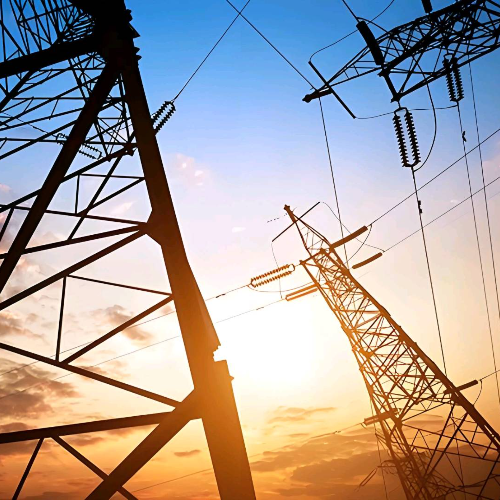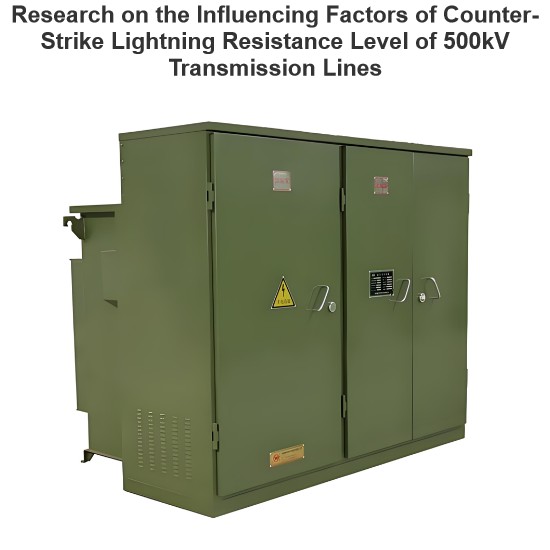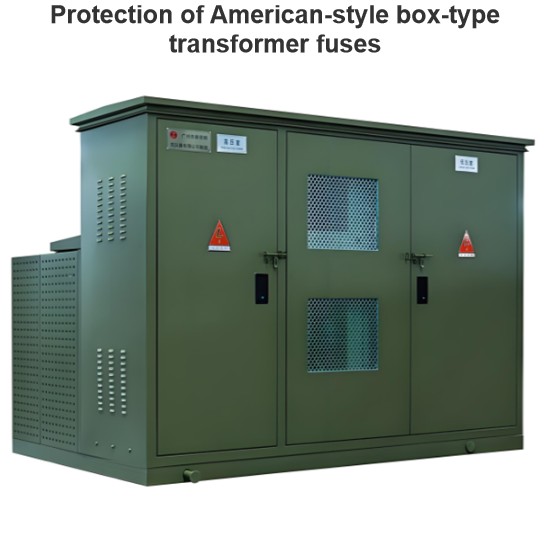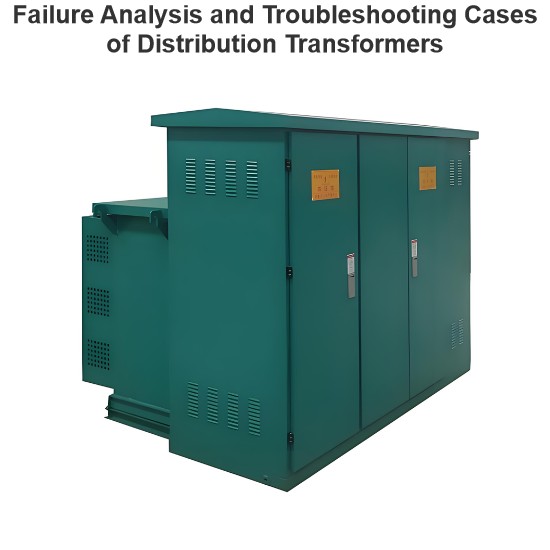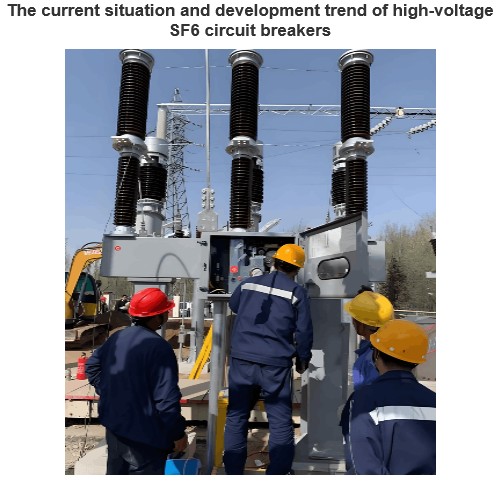In recent years, with the rapid development of the urban rail transit scale in China, the power and lighting load of subways has increased rapidly, and the problem of electric energy consumed by the self - losses of distribution transformers has become increasingly prominent. Against the backdrop of the country's advocacy for energy conservation and environmental protection, amorphous alloy core transformers, which use amorphous alloy strips with excellent magnetic conductivity as the magnetic - conducting material, have achieved relatively low no - load losses and no - load currents, and thus have become one of the development directions of energy - saving transformers. Taking Line 14 of the Beijing Subway as the background, this paper starts with the principles, structures, and technical characteristics of dry - type amorphous alloy core distribution transformers (hereinafter referred to as "amorphous dry - type transformers"), briefly describes the on - site implementation effects, and puts forward relevant suggestions for long - term operation, aiming to provide references and experiences for the selection and application of distribution transformers in subways.
Structure and Working Principle of Amorphous Dry - Type Transformers
Structure of Amorphous Dry - Type Transformers
Amorphous alloy distribution transformers select an amorphous alloy with soft magnetic properties as the core material. It has high saturation magnetic induction intensity, ultra - low losses, low exciting current, and low coercivity, and is an energy - saving and environmentally friendly transformer with good stability. Amorphous dry - type transformers combine the characteristics of epoxy - cast dry - type transformers, such as low halogen content, flame retardancy, low smoke generation, and self - extinguishing properties, with the low - loss advantages of amorphous alloy strips, enabling them to better meet the needs of public environments such as subways.
Amorphous alloy strips are a kind of thin (with a thickness of about 0.03 mm) and brittle magnetic - conducting materials. Therefore, it is reasonable to design them into a wound core structure. At present, the structures of epoxy - cast amorphous dry - type transformers mainly fall into two categories, namely, the three - phase three - limb structure and the three - phase five - limb structure, as shown in Figure 1. The core of the three - phase five - limb structure is formed by combining four frames, as shown in Figure 2 a; the core of the three - phase three - limb structure is formed by combining three frames, as shown in Figure 2 b. Since the core cross - section of amorphous alloy transformers is rectangular, the high - and low - voltage coils are generally designed into a rectangular structure with rounded corners. Also, because the magnetic flux density and lamination factor of the amorphous alloy core are lower than those of silicon steel sheets, the volume of the amorphous alloy core is much larger than that of a silicon steel sheet core of the same capacity.The amorphous dry - type transformers on a certain subway line adopt a three - phase five - limb core design, which has the advantages of good heat dissipation, a compact overall structure, and a relatively small volume.
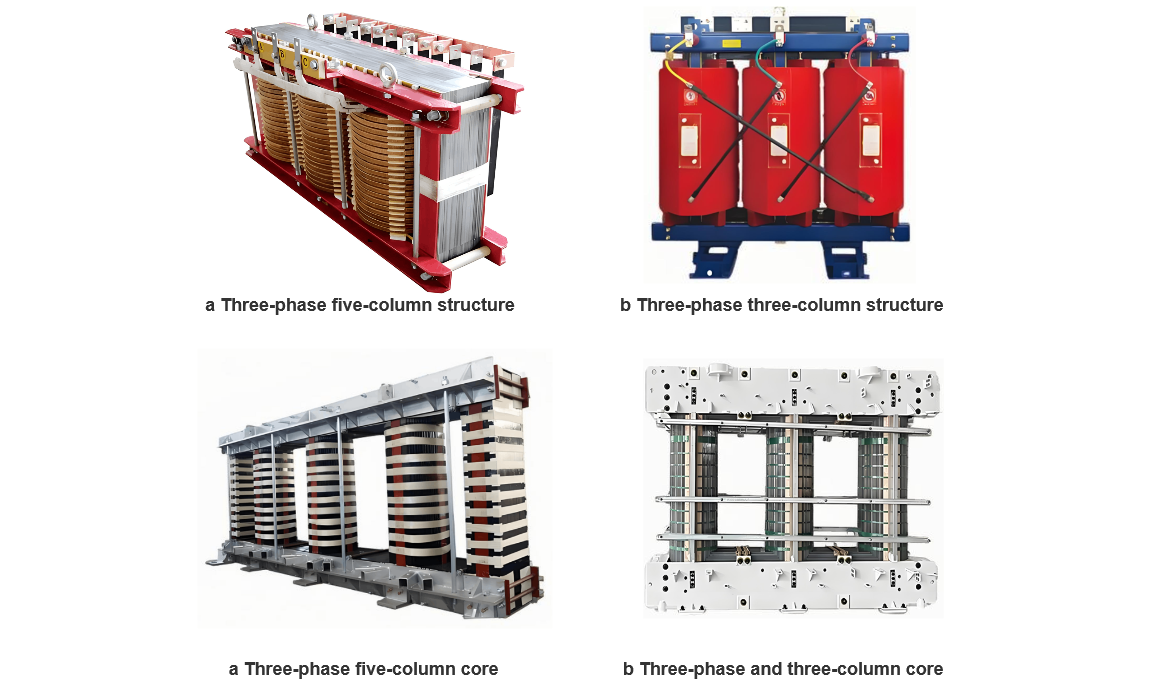
Working Principle of Amorphous Dry - type Transformers
The crystals of the amorphous alloy core material, silicon steel, are more conducive to magnetization and demagnetization due to their structure and characteristics. A typical amorphous alloy contains approximately 80% iron, with other main components being materials such as silicon and boron. A large number of tests have shown that the crystallization temperature of the amorphous alloy is 550°C, and the Curie temperature is about 415°C. These temperatures can meet the requirements for the processing of the amorphous alloy, the annealing after core forming, the normal operating temperature, and the thermal - stable temperature during short - circuits, so there are no issues in the application of amorphous dry - type transformers.
Taking a three - phase, four - frame, five - limb amorphous alloy distribution transformer as an example, since each winding is sleeved on two frames with independent magnetic circuits, the magnetic flux of each frame consists of fundamental - wave magnetic flux and some third - harmonic magnetic flux. The ratio of the third - harmonic to the fundamental - wave depends on the rated magnetic flux density. However, the third - harmonic magnetic fluxes in the two core frames of one winding are opposite in phase and equal in value. Therefore, the third - harmonic magnetic flux vector in each winding is zero. When the high - voltage coil is connected in a delta (D) configuration, there is a path for the third - harmonic current in the coil. As a result, there is generally no third - harmonic voltage component in the induced secondary - side voltage waveform. Nevertheless, the no - load loss in each frame is still affected by the third - harmonic current within that frame. The two side yokes of this structure can provide a path for the zero - sequence component or higher - order harmonics in the magnetic flux.
Main Technical Characteristics of Amorphous Dry - type Transformers
Characteristics of Amorphous Dry - type Transformers
Amorphous alloy strips are extremely sensitive to pressure. Once damaged, they cannot be restored. Therefore, during the manufacturing process, the following two points must be ensured: First, the core only bears its own weight, and the weight of the high - and low - voltage coils is supported by steel - structure components such as the base, upper and lower clamping pieces. Second, the short - circuit withstand capability is improved through optimized design structure.
The rectangular - structured windings of amorphous dry - type transformers are not as uniformly stressed as circular windings. When the transformer withstands short - circuit current, the long - axis direction is more prone to deformation. In actual production, the high - voltage windings are rigid - structured wires cast with epoxy resin and fixed in the resin layer. Dynamic and thermal stability calculations and practical simulations have proven that the high - voltage coils can withstand the electrodynamic force during short - circuits.
The low - voltage windings are mostly wound with copper foils and have a thermally cured epoxy - resin end - sealing structure, with slightly lower rigidity. They are prone to deformation during short - circuits, subjecting the amorphous alloy strips to stress. Therefore, during the design process, a large ratio between the long and short axes of the low - voltage coil windings should be avoided. Moreover, during the assembly process, supporting spacers must be placed between the core and the low - voltage coils to enhance the short - circuit withstand capability.
The noise of a transformer mainly comes from the magnetostriction of the core. The magnetostriction of amorphous alloy is approximately 10% higher than that of silicon steel sheets. By comparing the national standards "JB/T 10088 - 2004 Sound Levels for 6 kV - 500 kV Power Transformers" and "GB/T 22072 - 2008 Technical Parameters and Requirements for Dry - type Amorphous Alloy Core Distribution Transformers", it can be seen that the noise requirements for dry - type amorphous alloy core distribution transformers in the national standards are the same as those for silicon steel sheet core distribution transformers.
This increases the difficulty of manufacturing amorphous dry - type transformers. However, through the rational design of the structure of amorphous dry - type transformers, the noise can still be controlled within the national standard range. The magnetic flux density is an important factor affecting the noise of amorphous dry - type transformers.
For every 0.05 T increase in magnetic flux density, the no - load noise increases by approximately 2 dB(A), and the transformer noise increases by 5 dB(A)[1]. Therefore, the magnetic flux density of amorphous dry - type transformers should be reasonably selected to achieve noise reduction. Under normal circumstances, a magnetic flux density of less than 1.25 T is sufficient for amorphous dry - type transformers.
However, considering the special situation of high passenger flow density in subways, the noise level should be controlled even lower, and the magnetic flux density is generally selected to be less than 1.2 T. In addition, the noise of amorphous dry - type transformers needs to be suppressed by optimizing the structure. For example, appropriate space should be left in the frame composed of the core and clamping pieces to avoid excessive stress on the core and control the increase in core vibration. Sound - absorbing materials should also be padded between the core and the frame to effectively reduce noise.
During transportation and installation, amorphous dry - type transformers should be strictly operated in accordance with the operation specifications and procedures to avoid situations such as the core being stressed or knocked.
Economic Performance Analysis of Amorphous Dry - type Transformers
Amorphous dry - type transformers have obvious energy - saving effects. The following conducts an economic analysis of SCBH15 - type amorphous dry - type transformers and SCB10 - type silicon steel sheet distribution transformers with different capacities. The comparison is made in terms of the value of amorphous materials and silicon steel sheet materials, annual electricity cost savings, the number of years to recover the additional cost, and cost savings, as shown in Table 1.
It can be seen from Table 1 that amorphous dry - type transformers have more advantages in energy - saving compared to traditional silicon steel sheet transformers. Translated into operating costs, it is quite remarkable. The maximum number of years to recover the additional cost is only 5 years, showing great application prospects.
Application and Effect of Amorphous Dry - type Transformers in Subways
Application of Amorphous Dry - type Transformers in Subways
Through the elaboration of the structure and principle of amorphous dry - type transformers and the economic performance analysis, combined with the engineering situation of Line 14 of the Beijing Subway, for the application scheme of amorphous dry - type transformers, key research should be carried out on technical aspects such as the short - circuit withstand capability, noise control, loss index, and installation scheme of amorphous dry - type transformers, so as to give full play to the good energy - saving performance of amorphous dry - type transformers and improve the energy - saving level of subways.
On - site Implementation Effect
Taking the SCBH15 - 800/10/0.4 amorphous dry - type transformer that has been put into operation on Line 14 of the subway as an example, compared with the SCB10 - 800/10.0.4 dry - type transformer, ΔP0 = 1.05 kW; ΔPk = 0. The annual reduction in power consumption of one unit can be calculated as follows:
ΔWk = 8 760×(1.05 + 0.62×0) = 9 198 kW·h
Through calculation, it can be seen that the energy - saving effect of amorphous dry - type transformers is relatively obvious.

Relevant Suggestions for Long - term Online Operation
For the long - term operation of amorphous dry - type transformers on subway lines, their design, production, maintenance, and overhaul should be meticulously carried out in accordance with their unique characteristics. The author puts forward the following suggestions:
- Given that the magnetic saturation density of amorphous alloy materials is relatively low and their magnetostriction is relatively large, during product design, the rated magnetic flux density should not be set excessively high. Generally speaking, it is preferable to select a value below 1.2 T.
- Throughout the design and production processes, due attention must be paid to the short - circuit withstand capability of amorphous dry - type transformers. This capability should be enhanced through means such as process refinement and structural optimization.
- Amorphous alloys exhibit extreme sensitivity to mechanical stress. Therefore, in structural design, it is necessary to avoid the traditional design approach that uses the core as the main load - bearing component.
- To achieve excellent low - loss characteristics, annealing of the amorphous alloy core is an indispensable process.
- Regular maintenance and repair of amorphous dry - type transformers are essential. This helps to eliminate potential safety hazards and prolong the service life of the transformers.
Conclusion
Against the backdrop of the country's vigorous promotion of energy conservation and emission reduction, all industries are making strenuous efforts to cut down energy consumption. As a significant electricity consumer within urban power grids, the widespread adoption of amorphous dry - type transformers in subways is in line with national industrial policies and holds broad prospects for application.
It should be noted that the cost of amorphous alloy distribution transformers is higher than that of traditional silicon steel sheet transformers, and their installation also has certain unique features. Therefore, a rational transformer selection scheme should be formulated based on a comprehensive analysis of regional and line - specific conditions.
Since amorphous alloy distribution transformers demand a high standard of design and production processes, when choosing suppliers, it is advisable to opt for enterprises that have a track record of successful applications and possess advanced technical capabilities.

